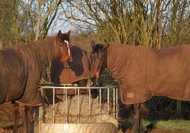Most of our equine friends have probably been enjoying 24/7 turnout over the summer months. Popular horse management thinking is that healthy horses and ponies benefit from the more natural direction of full time turnout like their wild cousins, but with autumn coming in, and the prospect of winter horse management just around the corner, what's the best course of action?
Basically there are three options for winter horse management as the weather turns for the worse: In all the time; stabled selectively according to weather conditions and/or overnight; or stay turned out (preferably rugged up and with a field shelter) for the duration.
Let’s look at the pros and cons of each option in more detail, bearing in mind that there are no hard and fast rules since each animal is different and has different needs.
Keeping a Horse in Over Winter
This is undoubtedly the most time consuming and difficult option for the horse owner, and may well not be healthy either physically or mentally for the horse.
There are pros of course if you choose this course of winter horse management:
You’ll know your horse is safe from extreme weather, and from suffering injuries in muddy paddocks. It also safeguards them from issues like mud fever and rain scald.
It’s far easier to keep your horse clean and comfortable if he’s confined indoors, and more comfortable for you to spend time tending to his physical needs and condition.
You can monitor and control your horse’s diet and weight, and any medical conditions, far easier when he’s living in the stable full time.
The cons of keeping a horse confined for months though are just as important:
Stabled horses are more likely to develop respiratory disorders brought on by bad ventilation and dusty bedding. Colic is also a risk, because they may eat their bedding.
You may well end up with behavioural issues because a confined horse will be bored and irritable.
Lack of exercise can cause joint and muscle problems, especially in older, arthritic horses.
You’ll have to visit your horse often to feed and clean him and his environment – and keep him entertained. Ideally you’ll need to take him out to lunge him, school him or for a short hack when weather permits.
In at Night, Out During the Day
Keeping your horse in at night time, or when the weather is particularly bad, is the most popular winter horse management choice for owners – and one followed by most livery yards.
You’ve probably noticed that horses are very keen to come in at night if they’ve been out in winter, waiting for the opportunity to get into the stable. This could, however, be just as much down to the fact that they know they’re going to be fed than an eagerness to get indoors.
The pros for this winter management routine are:
The horse will be happy being able to socialise and play with his herd mates for much of the day, enjoy relative freedom and have some exercise.
If the correct food, water and salt licks are left available they can browse and feed at will in a more natural way.
Because you’ll be having to visit your horse morning and evening to lead them in and out for the day, you are well-placed to judge the best way to rug them up – or not – for the particular day’s weather prospects.
When it comes to the cons for this winter horse management programme, they are similar to those for constant stabling:
Your horse will demand your attention rather intensely. You’ll have to be there morning and night at the very least, mucking out the stable, feeding and grooming.
You’ll need to monitor your horse carefully for injuries sustained in the paddock, and look after his feet in muddy conditions.
The horse might become depressed, fed up and bored spending too many hours of darkness alone in his stable. You can alleviate this risk by introducing stable toys and a haynet to keep him busy.
Full Time Winter Turnout
All the experts say that 24/7 turnout in all seasons is the ideal for a horse. Of course, this type of winter horse management doesn’t work for all – it depends on age, condition, susceptibility to medical problems, and the elements.
It’s also obviously not wise to suddenly decide that you’re going to leave a previously cosseted horse or pony out for the winter because it’s the fashionable thing to do. If your horse is used to full time turnout, he’ll probably be fine, but it’s best to make sure there’s a field shelter available and that you have heavy rugs on hand when things become icy.
Pros for Spending the Winter Out:
You’ll reduce the risk of your horse becoming depressed and difficult if he’s out in the field with his mates, and reduce the chances of him developing behavioural issues and stable vices.
Your workload in caring for your horse will be reduced. You still need to visit him twice a day to feed and water him, but there’ll be no mucking out and worrying about him being bored or lacking in basic exercise and stimulation.
Full time turnout is good for hoof health – constant movement promotes good blood circulation, and standing on damp, soiled bedding in a stable all day can cause things like thrush and white line disease. It helps with gut health too.
Cons … well, yes, there are some:
Just because he’s outside all the time doesn’t mean you can neglect your horse. He still needs monitoring, feeding and watering and human handling – perhaps more than ever. So, don’t think you can leave him in the field to his own devices.
A horse in the field is more prone to injuries, either from interaction with his field mates or hazards like fences, branches, slippery mud and so on. Mitigate this by making your winter turnout paddocks as hazard free as possible.
Your outdoor horse will be shaggy and dirty – definitely not of show standard!
Ultimately, you’re the one who knows your horse best – so the choice is yours. In or out, winter or summer, make sure your paddock is big enough, hazard free and that you keep up a good care routine especially with legs and feet. Keep a close eye on his weight and condition.
The key is to keep your horse in the most natural way possible, according to his own individual needs and the work you expect him to do for you.
Whatever your preferences for winter horse management, Totally Tack is here to help and advise. Dawn has her own three horses and an MSc in Equine Science, while John is a Master Saddler. Give us a call on 01373 228 242 or email info@totally-tack.co.uk.



